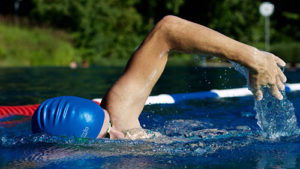 I love swimming. My first athletic language was swimming. Swimming opened doors and took me places I never could have imagined the first time I participated in a formal swim workout. So, I experience both a sadness and an excitement when I hear someone lament their poor swimming. Sadness because I would like that everyone shares my joy of swimming and swims proficiently; excitement because every person that asks me how they can swim faster is another opportunity to help someone improve their swimming.
I love swimming. My first athletic language was swimming. Swimming opened doors and took me places I never could have imagined the first time I participated in a formal swim workout. So, I experience both a sadness and an excitement when I hear someone lament their poor swimming. Sadness because I would like that everyone shares my joy of swimming and swims proficiently; excitement because every person that asks me how they can swim faster is another opportunity to help someone improve their swimming.
I always answer the “How do I swim faster” question the same way:
- Fundamentals
- Technique
- Frequency
- Structure
- Volume
Fundamentals – When someone attends a beginner swimming class, the first thing they are taught is the fundamentals of swimming – putting your face in the water WITHOUT goggles or a nose plug, blowing bubbles by exhaling out your mouth and/or your nose, learning how to float, gliding, learning how to kick. None of those skills, by themselves, can be considered swimming. Yet, those very skills form the foundation upon which swimming is built. You wouldn’t build a house without a proper foundation yet athletes that take up swimming later in life are often quite content to overlook the foundation. Are you having a hard time with your breathing? Maybe your legs are dropping and causing excess drag? Both of those problems likely can be traced back to lack of a fundamental skill.
Swim Technique – Swimming is a highly technical sport. Have you spent time with a qualified coach or instructor? If so, how frequently? A one-time lesson will get you started, but weekly lessons over several weeks will lay the foundation for a successful triathlon swimming career. If you are intent on doing it yourself, without coaching, here are some things to think about:
- Know what your body is doing – EVERY time I show an athlete video of themselves swimming, their reaction is universally, “I didn’t know I was doing that.” The first step to improving is knowing what your body is doing. A coach/instructor on-deck or video analysis can be helpful with this.
- Know what your body should be doing – There are countless videos available online that demonstrate proper swim technique. Doing a simple internet search for “freestyle technique,” will yield a plethora of articles and videos that may be valuable to you.
- Know how to make the change from what your body IS doing to what your body SHOULD be doing – Once you know what changes need to be made, you need to figure out HOW to make the changes. This is where a knowledgeable coach-on-deck remote video analysis by a coach is most valuable.
- Drills – I’m of the opinion that triathletes do entirely too many drills and spend WAY too much time doing those drills. That isn’t too say that drills don’t have their place in a well-planned workout – they do. However, doing the wrong drill is more detrimental than doing no drill because not only will the wrong drill not fix the issue the drill was supposed to fix, it also takes away valuable yardage from the workout. Drills should ONLY be used when prescribed by a qualified coach/instructor and then only for a limited period – generally less than a couple of weeks. Doing a drill because your friend did it and it helped or because you read on the internet it will help isn’t a valid prescription for a drill.
- The ability to apply the necessary changes to your technique – By successfully navigating the first three points, the self-coached swimmer can accomplish this with patience, perseverance, and multiple video sessions.
Frequency – Because it is so technical, swimming has a bio-mechanical component that is directly related to how frequently you touch the water. Your “feel’ for the water will increase and decrease in direct proportion to the number of days in the water and away from the water. All my athletes who swim 4-5 times per week make larger gains than those who only swim 2-3 times per week. That isn’t solely related to volume. Athletes that weekly swim 4-5 x 30-minutes will consistently experience larger gains than those that swim 2-3 x 60-minutes per week, even though the swimmer doing fewer workouts may be swimming higher overall volume. The athlete swimming less frequently spends the first part of their workout with poor technique as they reacquire form while the athlete swimming more frequently has good technique immediately upon entering the water. Even getting in the water and swimming only a few hundred focused yards can make a difference. Frequency matters!
Having trouble getting to the pool a couple more times a week? Plan a ride or a run so it ends at the pool and do a 500-1,000-yard abbreviated swim workout. For most athletes that will typically only add 15-20 minutes and your swimming will thank you.
Structure – There are two different ways you can structure your swim workouts – long continuous swims or intervals. Intervals help you maintain proper technique by providing intermittent rest breaks that allow you to recover so you don’t fatigue. Interval workouts can be broken down into two different formats – 10 x 100 w/20” rest or 10 x 100 @ 1:45 send-off. The 10 x 100 w/20” rest allows you to swim at whatever pace you choose and still get 20” rest. The 10 x 100 @ 1:45 send-off set requires you to swim at a specific pace to get a rest interval. Having a set rest interval is good during the base phase. If you continue to use a set rest interval for the entire season you’ll be a swimmer that can swim a very long way, but you won’t swim very fast. Using intervals with a specific send-off will build endurance while increasing your speed. The most effect swim workouts are achieved by using your swim threshold pace to determine a specific send-off interval.
Volume – The final piece to the “become a faster swimmer” puzzle is volume. You should strive to build to a volume equal to 1.5-2.0 times your ‘A’ race swim distance 3-4 times per week. Ideally you will swim your maximum volume during the 6-weeks immediately before you begin the taper for your ‘A’ race.
Develop a Love for Swimming – if you dread swimming, if you despise putting on your swim wear and getting into the pool, if you must force yourself to do a swim workout – you will never reach your potential as a swimmer. Learn to love swimming. Swimming isn’t your enemy. With just a little bit of focus on the right areas, you can become a proficient triathlon swimmer and turn your weakest discipline into your strongest.
